Toyota electric cars: how the Japanese giant is entering the EV era
Toyota’s Beyond Zero electric programme: could this EV be seen on 19 April 2021?
► Toyota targets 3.5 million EV sales per year by 2030
► Plans to launch 30 new BEVs within the same period
► Lexus to be EV-only in Europe by the end of the decade
For the last two decades, the Toyota Prius has dominated the hybrid car market, offering many motorists a stepping-stone between electric and combustion cars. Thanks to its incredible efficiency and relatively low price, the Toyota’s hybrid has become synonymous with Uber and other ride apps. But what about Toyota’s electric offering?
Turns out, Toyota’s EV range is not as expansive or as comprehensive as its rivals – not something you’d expect from the makers of the electrified Prius. The Japanese brand is playing catch-up – but it has big plans to close the gap.
In December 2021, Toyota revealed its complete range of upcoming electric car. Sixteen Toyota electric cars were shown during the presentation, ranging from a tiny electric SUV to a mid-sized electric family saloon and even a flagship electric supercar.
Toyota won’t stop there, though. The manufacturer’s boss, Akio Toyoda, has promised that buyers will have 30 Toyota electric cars vehicles to choose from by 2030. That figure includes the brand’s passenger and commercial vehicles, as well as premium offerings from Lexus.
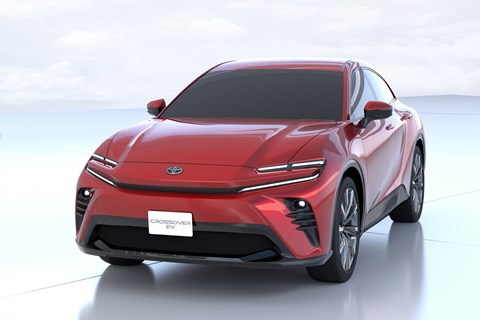
With this aggressive strategy, Toyota aims to sell 3.5 million BEVs per year by the end of the decade, which is around 1.5 million more than the company manages today. As a result, BEVs will also make up a larger percentage of the brand’s total 10 million yearly vehicle sales.
Mục Lục
And how much money is this going to cost?
President Toyoda said his firm will plough 4 trillion yen (around £24 billion) into electric vehicles and next-generation batteries between now and 2030 – and that a similar sum will be dumped into hybrid, hydrogen and other powertrain technologies. He wants Toyota’s manufacturing plants to be completely carbon neutral by 2035, too.
‘We will continue to advance initiatives in all areas,’ he said. ‘Energy varies from region to region. Toyota is committed to producing a range of carbon-neutral options. Then our customers decide. A solution for the average person would not be the best solution for everyone.’
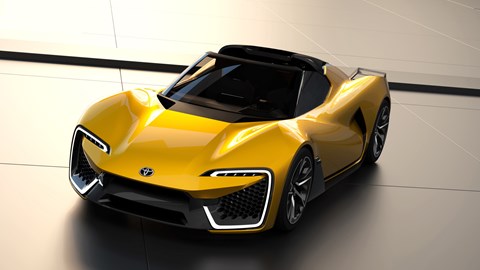
Design chief Simon Humphries added: ‘Our strength is understanding what customers really want. The biggest challenge is to increase customer acceptance of carbon neutrality.’
Akio Toyoda’s current stance on BEVs is surprising. He’s a keen race driver and has previously said that he was ‘not interested’ in electric cars. It seems his engineers have made enough progress to win him over, though, as he’s now changed his tune.
He said: ‘The [BEVs] we’re developing for the future I am interested in. We are now able to make a fun-to-drive car that you can drive safely. We are now at a point where a more safe and more fun-to-drive EV can be developed. It’s not any more just a business decision.’
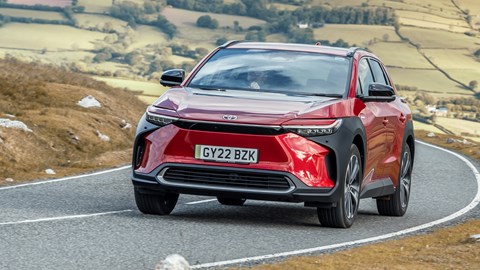
Toyota’s first electric car, the bZ4X (pictured above), is already on sale in the UK, offering a maximum range of 317 miles. It was co-developed with Subaru and has such spawned a badge-engineered variant from that brand called the Solterra, as well as a premium alternative from Lexus called the RZ450e.
These will be joined by an arsenal of Toyota-badged family cars, an electric Lexus sports car, a flagship Lexus electric SUV, an electric pickup and a mad supercar to rival the Lotus Evija. There are also plans for more utilitarian vehicles like the aptly named Micro Box and Mid Box – a pair of tiny electric commercial vehicles that look like wheeled Rubik’s Cubes.
How will Toyota power its new electric cars?
With batteries, of course. But Toyota is looking at ways of innovating in that area as well. In August 2022, Toyota took steps to secure its battery supply, spending around £4.5 billion on partnerships in Japan and the United States to increase its battery production capacity by investing in more efficient assembly lines and better workforce training. Toyota says its improved facilities in Himeji and North Carolina will start churning out batteries between 2024 and 2026.
Toyota is also working with Isuzu, Daihatsu and Isuzu on replaceable cartridge battery packs for its commercial vehicles. The system works on similar principles to Nio’s Power Swap Stations – empty batteries are replaced for fully charged ones at dedicated swap stations, dramatically reducing the amount of time drivers spend refuelling their electric cars.
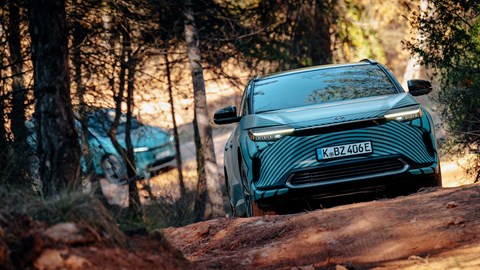
Toyota claims this method could reduce the cost of its BEVs, too. Because cartridge battery packs eliminate long recharge times, their capacity can be smaller – and that means the raw materials for the cells can be spread more thinly over more battery packs, giving the potential to power more electric cars with the same resources. It’s a clever bit of lateral thinking.
What about hydrogen fuel cells?
Toyota has dabbled with the hydrogen fuel cell since it launched the first-generation Mirai in 2014. Since then, the brand has done a lot to improve the technology – the company even showcased a portable hydrogen cartridge prototype (pictured below) in June 2022 that can power small-scale hydrogen fuel cells in everything from homes and appliances to motorbikes and cars.
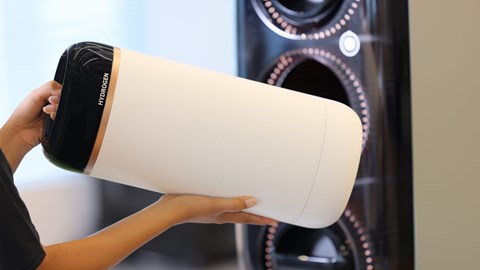
The idea is, rather than going to a filling station for hydrogen, you simply pick up a couple of cartridges and slot them into whatever you need to power. The cartridges are charged at a central location, thereby eliminating the need for a hydrogen infrastructure and they can be chained together to power more energy demanding items.
Toyota has refined the Mirai, too. The Mk2 model was launched in 2020 and, unlike the original car (which sold a measly 10,000 examples during its six years on sale), it was designed to sell. We’ve driven it – and we can confirm that it has a more luxurious cabin, a better chassis and a longer maximum range of 400 miles. The only thing holding it back is the pitiful hydrogen infrastructure.
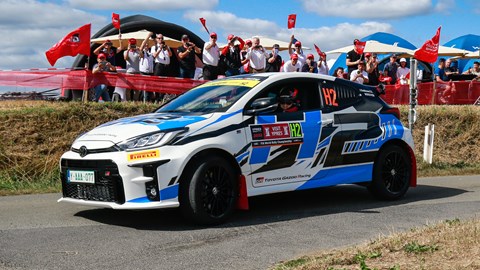
If that wasn’t enough, Toyota is also designing internal combustion engines that can run on pure hydrogen. The brand already has a prototype GR Yaris rally car (above), powered by a modified version of Toyota’s 1.6-litre three-cylinder petrol engine. It produces almost no tailpipe emissions (most of the gas coming out of the exhaust is water vapour), but it sounds and feels like a petrol car to drive.
Plug-in hybrid Toyotas
There have been two generations of Prius plug-in hybrid, which have now been joined by a PHEV version of the RAV4. Its powertrain comprises a 2.5-litre four-cylinder petrol engine, an electric motor and an enormous 18.1kWh battery pack – enough for a maximum electric range of 46 miles.
The extra electrification has made the RAV4 significantly quicker, too. Its PHEV powertrain produces 302bhp and can propel the SUV from 0–62 in 6.2 seconds which is bordering on hot hatch territory. Drive it like you’re not on the run from the law and Toyota says it’ll return more than 280mpg.
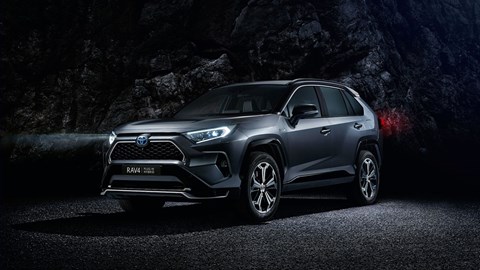
To mark it out as the range-topping plug-in model, the RAV4 PHEV gets a restyled nose, model-specific 19-inch alloy wheels, black leather upholstery and a nine-inch infotainment screen, which is the biggest fitted to any model in the RAV4 range.
Self-charging hybrid Toyotas
Those old things? Well, self-charging hybrids have been the bedrock of Toyota’s success since the first-generation Prius was launched in the late 1990s. They’re still selling well today, which means Toyota is continuing to evolve the technology.
The most recent addition to the company’s range was the Yaris Cross. Its hybrid system is based around a new 1.5-litre three-cylinder petrol unit, which can return up to 65.9mpg on the WLTP cycle with emissions as low as 120g/km of CO2. As an interesting side note, the three-pot’s thermal efficiency is a diesel-beating 40%.
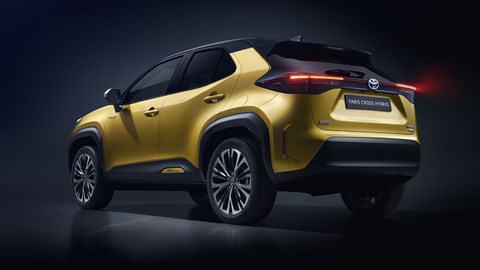
If you want something smaller, you can have the same engine in the conventional Yaris hatch where it returns an even more impressive 68.9mpg (according to the official WLTP regime). Toyota also launched a facelifted version of the Corolla mid-way through 2022, complete with a more efficient and more powerful version of its 1.8-litre and 2.0-litre petrol-hybrid powertrains.
Q&A with Matt Harrison

From Brexit to the engine ban and beyond – six huge questions about the future of Toyota, answered by Matt Harrison, executive vice-president, sales, at Toyota Motor Europe
How will you cope with petrol cars being banned in 2030?
‘It’s a long way to travel in the next decade to be delivering real accessible, high-volume, full-electric, zero-emission products. But we’re confident we can adapt as necessary.
‘The strategy to 2025 has been built to meet 80g/km of CO2 emissions, the further milestone that’s required. Probably by 2025 we’ll be a 70 per cent hybrid mix, about 20 per cent plug-in, plus the zero-emission vehicles entering the line-up, and about 10 per cent ICE by then.
‘Fast forward now to 2030, it seems very clear that they want to further challenge CO2 reduction to 50 per cent below the 2010 level, and that will probably mean we have to target something like 50 per cent of our mix to be plug-in plus zero-emissions vehicles. We’ll have a more challenging second half of the decade. But we’re lucky that we’re a manufacturer that has all of these technologies. We’re able to do that.
‘But it requires much more than the OEMs. It requires great collaboration in terms of infrastructure and the supply grid. We will do our best to make the products accessible. Full electrics are certainly gaining – around 10-11 per cent of the market is electrified today, and probably one third of that is fully electric, but heavily subsidised, and that’s what’s stimulating demand.’
Doesn’t the GR Yaris make the rest of the range look a bit dull?
‘We’re very respected, we’re reliable, we’re very durable. People buy us for rational reasons. People don’t buy Toyota for emotional reasons. We need more emotion. So the fact that we’ve managed to create the Supra and the GR Yaris is fantastic.
‘With 15 per cent of our Corrola and Yaris customers buying the GR Sport grade, that transforms our image. The halo products themselves might not make great financial sense, but when you add the whole thing together it does.
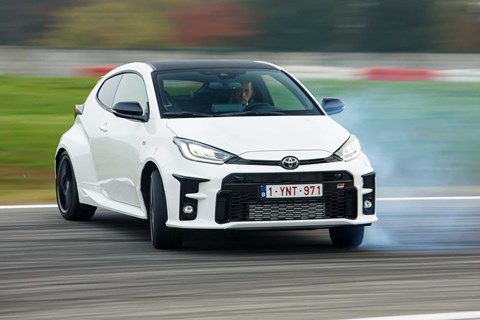
‘There will be more, not less, in the short term. But towards 2030 there’s going to be limits to the ICE products that can come, and the volume role that they can play in Europe, so increasingly those may have to be more electrified solutions.’
Why would anyone buy a pure-electric Toyota crossover instead of any other electric crossover?
‘We certainly want to protect the Toyota DNA in the product. From a design point of view, from a driving character point of view, from a safety point of view, from a refinement point of view, all of these things we will protect, and we will be consistent across all of these technologies.
‘We’re in an advantageous position where we’re not forced to move quicker than we’re comfortable to move [because Toyota’s hybrid-rich line-up means it’s comfortably meeting emissions targets]. We can really be driven by what the consumer actually wants.
‘Depending which region of the world you are in, or which country, different customers will naturally choose different solutions. But over time, as the scale of BEVs improves, the costs will improve, the range will improve and hopefully, as long as the infrastructure improves and the supply grid is upgraded accordingly, then naturally we will see that growth. But clearly the amount of incentivisation today is not sustainable.
‘We’re going one step at a time. We expect rapid increase of zero-emission vehicles from 2025, but we will let the customer determine the speed and what vehicle lines need to be prioritised. We’re still in discussion about the line-up we expect from 2025 onwards.’
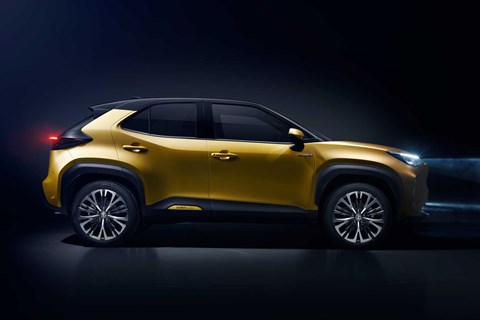
Are you serious about hydrogen?
‘We’re inundated with inquires and opportunities to collaborate or to join consortiums to advance deployment of hydrogen power solutions, right across all the transport sectors.
‘We have many cities talking to us directly saying how quickly can you help us mobilise this transition, under pressure on clean air and everything else.
‘We’re trying to collaborate with each of these sectors with the sole purpose of building the infrastructure, making it viable, and then the passenger car and light commercial vehicle volumes will be able to develop more quickly. It’s much more of a hydrogen society approach as opposed to a passenger car model launch plan.
‘We believe green hydrogen, with its storage capabilities, will, long term, be the optimal solution. But realistically you’re talking beyond 2030 before you see significant volumes.’
Why does Toyota keep calling itself a mobility provider, when mostly it just makes cars?
‘When you look at the challenges cities are facing in terms of pollution and congestion, we need to find better ways of integrating public transport with personal mobility solutions. We don’t see that as a complete change in business, just an expansion.
‘Covid has certainly dented the desire in the short term to share cars, but we learnt enough beforehand to know that the younger generation are not obsessed by ownership. Shorter term subscribptions, or having access to shared mobility solutions, is something that works very well for them, and I really expect that to come back.
‘Our vision is realistic. Where there’s sufficient demand for those services, we will deploy them. The future expansion of demand in these areas is a given. We’ll be ready to meet it.’
Are you worried about Brexit?
‘There seems to be great determination on both sides to find a solution. We’ve been very clear that we need a deal. As a major manufacturer in the UK, selling 90 per cent of our production into the EU, we need a relationship that’s tarrif-free and as hassle-free as possible. We’re focused on letting them do their job, and we’ll deal with the consequences. We’ll adapt, and focus on making ourselves competitive.’















![Toni Kroos là ai? [ sự thật về tiểu sử đầy đủ Toni Kroos ]](https://evbn.org/wp-content/uploads/New-Project-6635-1671934592.jpg)


